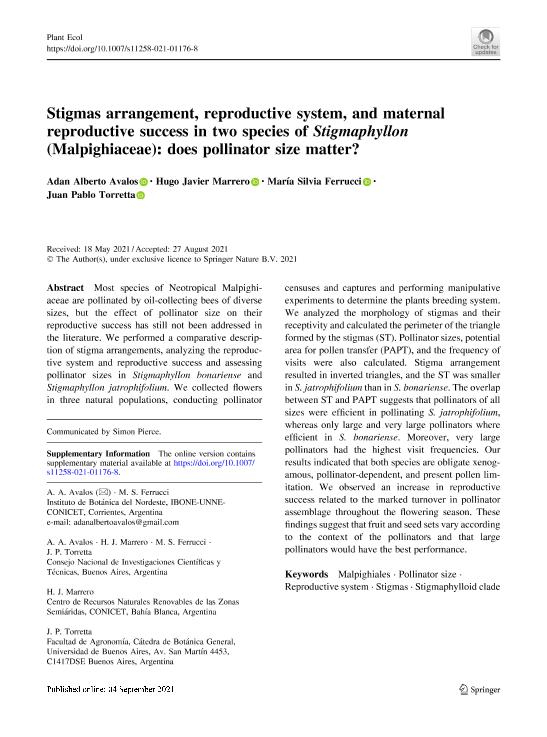Mostrar el registro sencillo del ítem
dc.contributor.author
Avalos, Adan Alberto

dc.contributor.author
Marrero, Hugo Javier

dc.contributor.author
Ferrucci, María Silvia

dc.contributor.author
Torretta, Juan Pablo

dc.date.available
2021-12-01T12:45:19Z
dc.date.issued
2021-09
dc.identifier.citation
Avalos, Adan Alberto; Marrero, Hugo Javier; Ferrucci, María Silvia; Torretta, Juan Pablo; Stigmas arrangement, reproductive system, and maternal reproductive success in two species of Stigmaphyllon (Malpighiaceae): does pollinator size matter?; Springer; Plant Ecology; 222; 11; 9-2021; 1263-1279
dc.identifier.issn
1385-0237
dc.identifier.uri
http://hdl.handle.net/11336/147836
dc.description.abstract
Most species of Neotropical Malpighiaceae are pollinated by oil-collecting bees of diverse sizes, but the effect of pollinator size on their reproductive success has still not been addressed in the literature. We performed a comparative description of stigma arrangements, analyzing the reproductive system and reproductive success and assessing pollinator sizes in Stigmaphyllon bonariense and Stigmaphyllon jatrophifolium. We collected flowers in three natural populations, conducting pollinator censuses and captures and performing manipulative experiments to determine the plants breeding system. We analyzed the morphology of stigmas and their receptivity and calculated the perimeter of the triangle formed by the stigmas (ST). Pollinator sizes, potential area for pollen transfer (PAPT), and the frequency of visits were also calculated. Stigma arrangement resulted in inverted triangles, and the ST was smaller in S. jatrophifolium than in S. bonariense. The overlap between ST and PAPT suggests that pollinators of all sizes were efficient in pollinating S. jatrophifolium, whereas only large and very large pollinators where efficient in S. bonariense. Moreover, very large pollinators had the highest visit frequencies. Our results indicated that both species are obligate xenogamous, pollinator-dependent, and present pollen limitation. We observed an increase in reproductive success related to the marked turnover in pollinator assemblage throughout the flowering season. These findings suggest that fruit and seed sets vary according to the context of the pollinators and that large pollinators would have the best performance.
dc.format
application/pdf
dc.language.iso
eng
dc.publisher
Springer

dc.rights
info:eu-repo/semantics/openAccess
dc.rights.uri
https://creativecommons.org/licenses/by-nc-sa/2.5/ar/
dc.subject
MALPIGHIALES
dc.subject
POLLINATOR SIZE
dc.subject
REPRODUCTIVE SYSTEM
dc.subject
STIGMAPHYLLOID CLADE
dc.subject
STIGMAS
dc.subject.classification
Ciencias de las Plantas, Botánica

dc.subject.classification
Ciencias Biológicas

dc.subject.classification
CIENCIAS NATURALES Y EXACTAS

dc.title
Stigmas arrangement, reproductive system, and maternal reproductive success in two species of Stigmaphyllon (Malpighiaceae): does pollinator size matter?
dc.type
info:eu-repo/semantics/article
dc.type
info:ar-repo/semantics/artículo
dc.type
info:eu-repo/semantics/publishedVersion
dc.date.updated
2021-11-09T18:54:58Z
dc.journal.volume
222
dc.journal.number
11
dc.journal.pagination
1263-1279
dc.journal.pais
Alemania

dc.description.fil
Fil: Avalos, Adan Alberto. Consejo Nacional de Investigaciones Científicas y Técnicas. Centro Científico Tecnológico Conicet - Nordeste. Instituto de Botánica del Nordeste. Universidad Nacional del Nordeste. Facultad de Ciencias Agrarias. Instituto de Botánica del Nordeste; Argentina
dc.description.fil
Fil: Marrero, Hugo Javier. Consejo Nacional de Investigaciones Científicas y Técnicas. Centro Científico Tecnológico Conicet - Mendoza. Instituto Argentino de Investigaciones de las Zonas Áridas. Provincia de Mendoza. Instituto Argentino de Investigaciones de las Zonas Áridas. Universidad Nacional de Cuyo. Instituto Argentino de Investigaciones de las Zonas Áridas; Argentina
dc.description.fil
Fil: Ferrucci, María Silvia. Consejo Nacional de Investigaciones Científicas y Técnicas. Centro Científico Tecnológico Conicet - Nordeste. Instituto de Botánica del Nordeste. Universidad Nacional del Nordeste. Facultad de Ciencias Agrarias. Instituto de Botánica del Nordeste; Argentina
dc.description.fil
Fil: Torretta, Juan Pablo. Consejo Nacional de Investigaciones Científicas y Técnicas; Argentina. Universidad de Buenos Aires. Facultad de Agronomía; Argentina
dc.journal.title
Plant Ecology

dc.relation.alternativeid
info:eu-repo/semantics/altIdentifier/doi/http://dx.doi.org/10.1007/s11258-021-01176-8
dc.relation.alternativeid
info:eu-repo/semantics/altIdentifier/url/https://link.springer.com/article/10.1007%2Fs11258-021-01176-8
Archivos asociados
